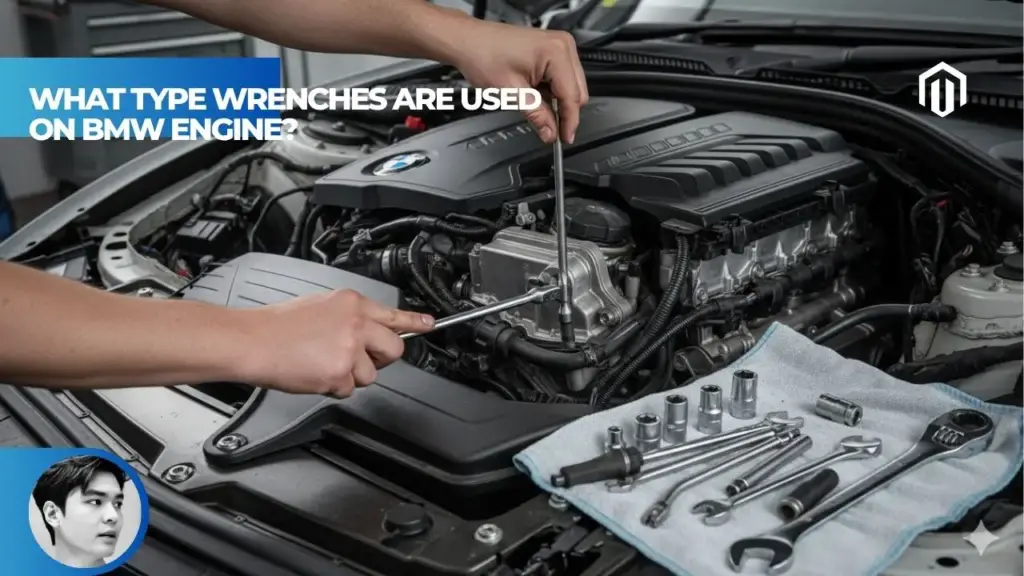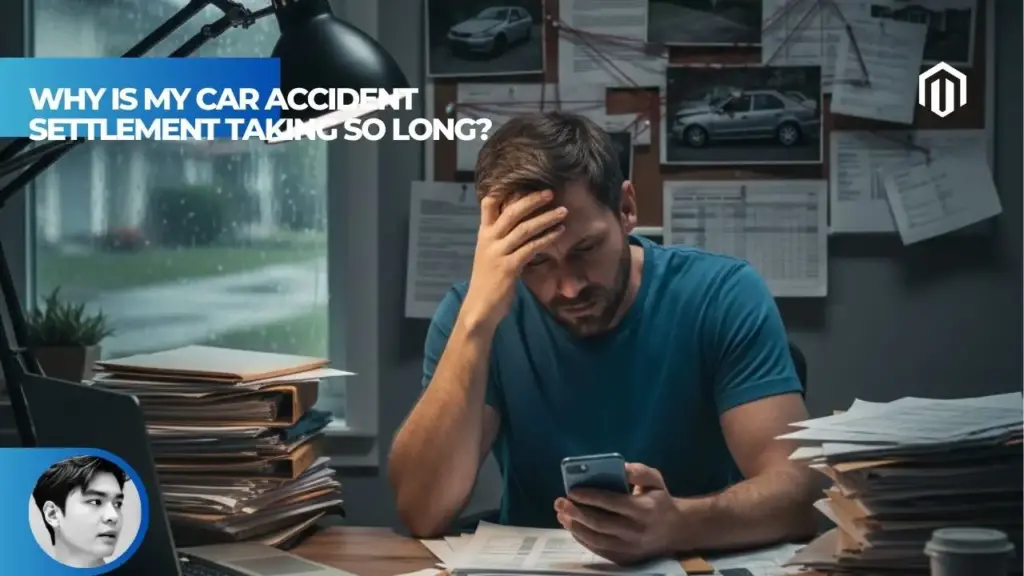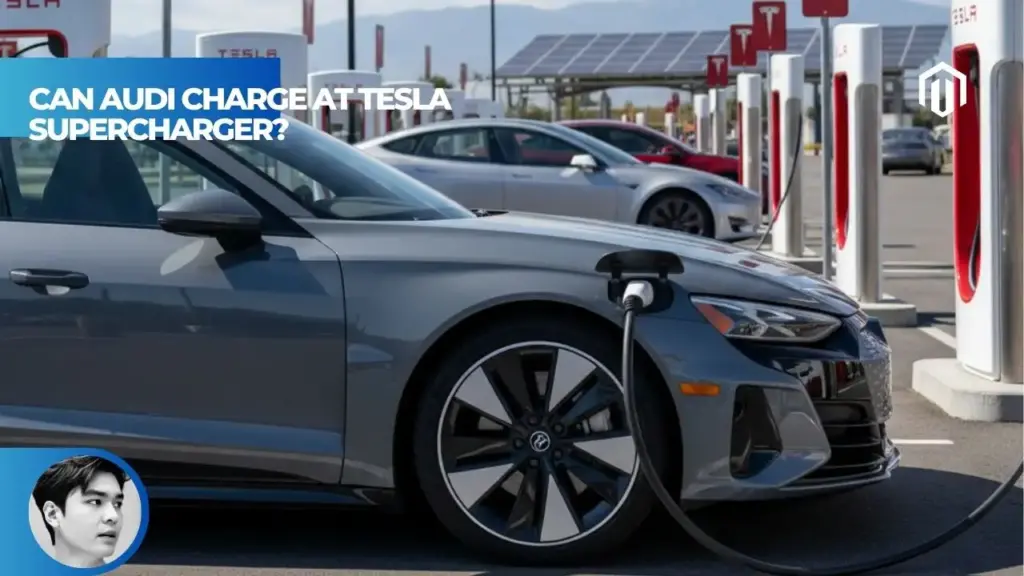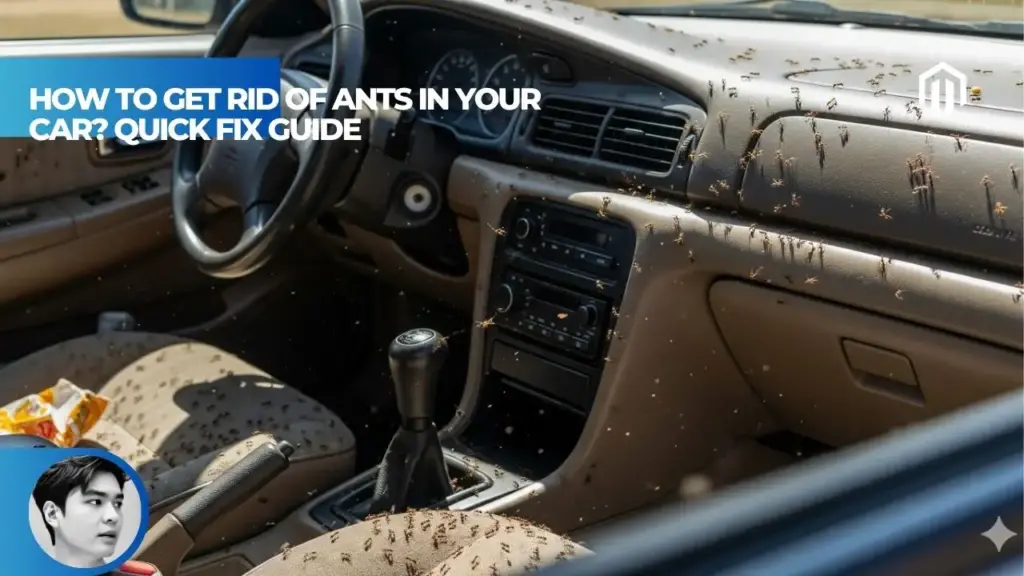You may also like:
- 【Explained】What Did BMW Start Making Before Cars? (From Planes to Cars)
- 【Explained】What Engine Does the BMW i8 Have? Full Hybrid Powertrain Explained
- 【Explained】Can BMW Charge at Tesla Supercharger? The NACS Adoption Timeline Explained
- 【Explained】What Is the Difference Between a BMW X3 and X5? (A 2025 Buyer’s Guide)
- 【Explained】What Is More Expensive: BMW or Mercedes? (Cost of Ownership)
BMW engines primarily require E-Torx (external) sockets ranging from E6-E24, internal Torx bits from T10-T60, and metric sockets from 8mm-21mm, with modern engines using specialized fasteners far more frequently than traditional hex bolts. A calibrated torque wrench with both 3/8″ and 1/2″ drive is mandatory for BMW’s precise torque-plus-angle specifications, while Triple Square (XZN) bits are essential for certain drivetrain components and high-stress applications[1].

Primary BMW Engine Wrench and Socket Types
Understanding BMW’s fastener philosophy is crucial before purchasing tools. According to Autvex’s analysis of BMW repair data, German engineering standards prioritize torque precision and fastener security over simplicity, resulting in a unique tool requirement profile that differs significantly from American or Japanese vehicles.
BMW Engine Inverted Torx (E-Torx) Sockets
E-Torx sockets, also called external or inverted Torx, represent the most critical tool investment for BMW engine work. These sockets feature an internal star pattern that engages external star-shaped bolt heads, providing superior torque transfer compared to traditional hex bolts[2].
Common E-Torx applications include:
- Engine-to-transmission bolts
- Exhaust manifold fasteners
- Subframe mounting points
- Oil pan bolts (certain models)
- Suspension components
- Differential mounting hardware
The E-Torx design prevents cam-out under high torque loads, making them ideal for critical engine components where precise torque specifications are mandatory.
BMW E-Torx Size Chart and Common Applications
A comprehensive E-Torx set should include sizes from E5 to E24, though certain applications may require larger sizes. Professional BMW technicians report using nearly every size across different repair scenarios[1].
| E-Torx Size | Common Applications | Drive Size |
|---|---|---|
| E5-E8 | Interior trim, small brackets | 1/4″ |
| E10 | M6 bolts, valve covers, sensors | 3/8″ |
| E12 | Oil drain plugs, coolant flanges | 3/8″ |
| E14 | Transmission bolts, suspension | 3/8″ |
| E16 | Engine mounts, subframe | 3/8″ or 1/2″ |
| E18-E20 | Heavy-duty suspension, drivetrain | 1/2″ |
| E22-E24 | Axle components, differential | 1/2″ |
Difference Between Torx and E-Torx on BMW
The distinction between standard Torx and E-Torx proves critical for proper tool selection. [Modern BMW engines] utilize both types extensively, making both sets essential[3].
Internal Torx (standard):
- Star-shaped recess in bolt head
- Requires Torx bits (T10-T60)
- Common on interior components
- Used for sensors and electronics
- Lower torque applications typically
External Torx (E-Torx):
- Star-shaped external bolt head
- Requires E-Torx sockets
- Heavy-duty applications
- Engine and drivetrain components
- High-torque specifications
BMW Metric Wrenches Sizes
While sockets dominate BMW engine work, metric combination wrenches remain necessary for specific applications. The most frequently used sizes range from 8mm to 21mm, with certain sizes seeing disproportionate use[4].
Essential metric wrench sizes:
- 10mm: Most common size, used extensively
- 13mm: Suspension components, brackets
- 16mm: Engine accessories, belt tensioners
- 17mm: Oxygen sensors, various fittings
- 18mm: Drain plugs, large fasteners
- 19mm: Wheel bolts, suspension
Essential Tool Kit for BMW Engine Maintenance
Building a comprehensive BMW tool collection requires strategic investment in both common and specialized tools.
BMW Engine Hex (Allen) Sockets Requirements
Hex socket bits, commonly called Allen keys, appear throughout BMW engines for precision applications requiring controlled torque. Modern engines increasingly use hex fasteners for critical components[5].
Required hex socket sizes:
- 4mm-10mm standard lengths
- 12mm, 14mm for specialized applications
- Both ball-end and straight configurations
- Long-reach versions for recessed bolts
- 1/4″ and 3/8″ drive compatibility
Common hex fastener locations include brake calipers, transmission drain plugs, and engine accessories.
Triple Square (XZN) Bits BMW Engine Applications
Triple Square bits, designated as XZN or 12-point spline drive, handle extreme torque applications where standard fasteners would fail. BMW drivetrain components frequently utilize these specialized fasteners[6].
XZN bit requirements:
- M5-M16 sizes most common
- M10 for cylinder head bolts (certain engines)
- M12 for transmission-to-engine bolts
- M14 for high-stress drivetrain components
- M16 for specialized applications
Investment in quality XZN bits proves essential as damaged bits can strip these expensive fasteners.
BMW Spark Plug Socket Size Specifications
Spark plug replacement requires engine-specific socket sizes with appropriate features for BMW’s deep plug wells[7].
Engine-specific spark plug sockets:
- N52/N54/N55: 14mm 12-point thin-wall
- B58/B48: 14mm 12-point extra-deep
- N63/S63: 12mm 12-point thin-wall
- N20/N26: 14mm 12-point standard depth
Features required:
- Magnetic or rubber insert for plug retention
- Thin-wall design for tight clearances
- Adequate length for deep wells
- 3/8″ drive for proper torque control
Open-End vs Combination Wrenches BMW
Professional BMW technicians report using sockets 90% of the time, with wrenches serving specific purposes where socket access proves impossible[4].
When to use each type:
Combination wrenches:
- Fuel line fittings
- Brake line connections
- Tight clearance areas
- Counter-holding applications
Open-end wrenches:
- Limited swing arc situations
- Quick positioning needs
- Secondary tool for holding
Ratcheting wrenches:
- Speed up repetitive tasks
- Improved access in tight spaces
- Reduced hand fatigue
BMW Engine Fastener Standards and Sizing
Understanding BMW’s fastener standards helps predict tool requirements and prevent damage from incorrect tool selection.
Are All BMW Bolts Metric
Yes, 100% of BMW fasteners use metric sizing following ISO standards, though the fastener types vary significantly from traditional hex bolts. This metric standardization applies globally across all BMW production[1].
Metric sizing implications:
- All socket and wrench sizes in millimeters
- Thread pitches follow metric standards
- Torque specifications in Newton-meters (Nm)
- No SAE/Imperial tools required
- Consistent sizing across model years
Common BMW Engine Bolt Sizes (16mm, 18mm)
Certain bolt sizes appear repeatedly throughout BMW engines, making these sockets high-priority purchases[8].
Most frequently used sizes:
- 8mm: Small brackets, clips, covers
- 10mm: Most common size overall
- 13mm: Medium-duty applications
- 16mm: Oil filter housing cap (many models)
- 17mm: Oxygen sensors universal
- 18mm: Drain plugs, suspension
Investment in quality sockets for these sizes pays dividends through repeated use.
BMW Bolt Grade Classes (8.8, 10.9)
BMW utilizes specific bolt grades indicating tensile strength, with markings determining proper torque specifications[2].
Common bolt grades:
- 8.8: Standard strength (800 MPa tensile)
- 10.9: High strength (1000 MPa tensile)
- 12.9: Ultra-high strength (1200 MPa tensile)
Grade identification:
- Numbers stamped on bolt head
- Higher grades require precise torque
- Never substitute lower grade bolts
- Torque specs vary by grade
Metric vs Imperial Tools for BMW
While BMW uses exclusively metric fasteners, certain diagnostic and specialty tools may reference imperial measurements, particularly older test equipment[3].
Tool considerations:
- Primary tools: 100% metric required
- Torque wrenches: Dual scale (Nm/ft-lb) helpful
- Measuring tools: Metric preferred
- Drill bits: Metric for precision work
- Tap and die sets: Metric thread pitches only
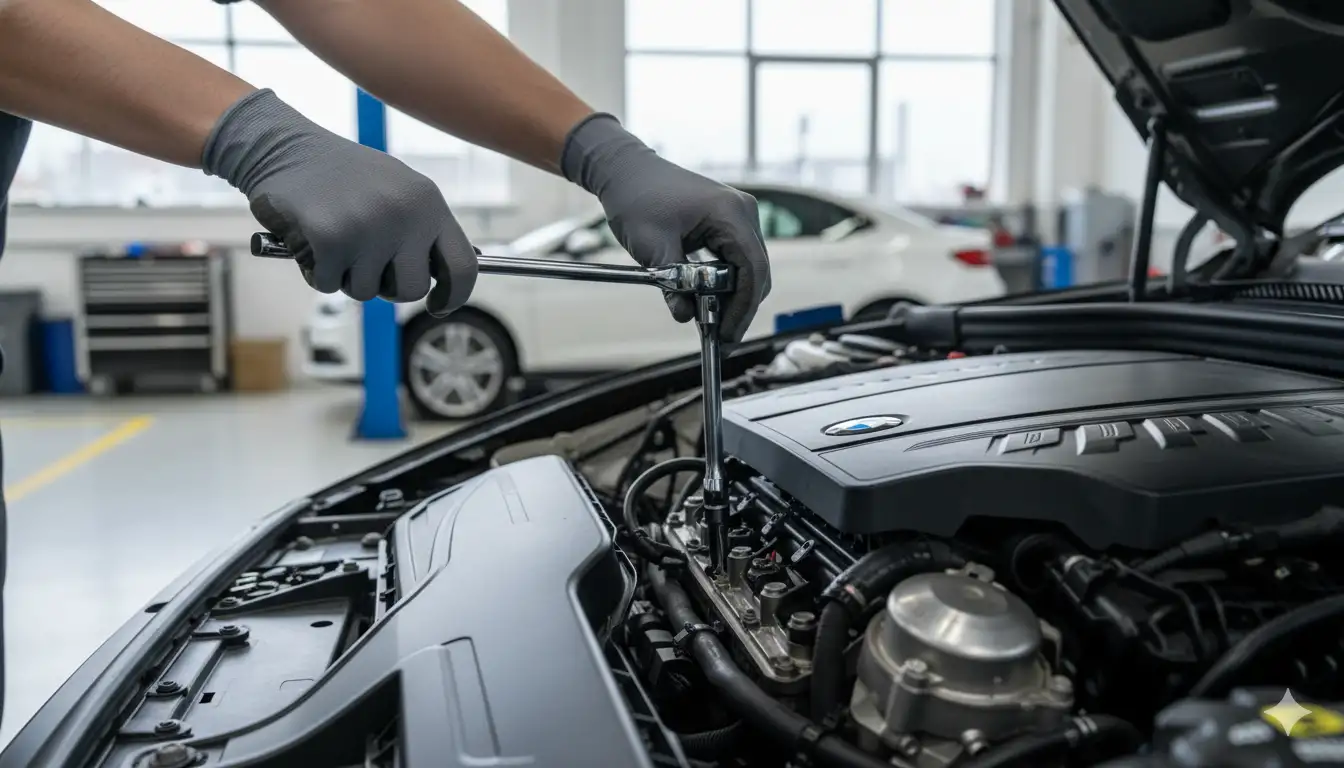
Specialized Tools for BMW Engine Repair
Beyond basic hand tools, BMW engine work demands specialized equipment for proper repairs.
Torque Wrench Requirement for BMW Engine
A quality torque wrench represents the single most critical tool for BMW engine work, as improper torque causes immediate or progressive failure. According to Autvex research, incorrect torque accounts for 30% of BMW engine damage during DIY repairs[9].
Torque wrench specifications needed:
3/8″ drive (20-100 ft-lb):
- Most engine fasteners
- Valve covers
- Sensors and accessories
- Spark plugs
1/2″ drive (50-250 ft-lb):
- Wheel bolts
- Suspension components
- Crankshaft bolts
- Head bolts
1/4″ drive (20-200 in-lb):
- Small fasteners
- Interior components
- Electronics
Angle Torquing Method BMW
BMW extensively uses torque-to-yield (TTY) bolts requiring initial torque followed by additional rotation degrees. This method ensures consistent clamping force regardless of friction variations[10].
Angle torquing procedure:
- Initial torque to specification (e.g., 30 Nm)
- Pause for settlement (10-30 seconds)
- Additional rotation (e.g., 90 degrees)
- Further rotation if specified (e.g., +90 degrees)
- Mark bolts as non-reusable
Common TTY applications:
- Cylinder head bolts
- Connecting rod bolts
- Main bearing cap bolts
- Certain suspension components
Oil Filter Wrench Size for BMW
BMW’s cartridge-style oil filters require specific cap wrenches matching the housing design. Similar to Audi systems, these differ from traditional spin-on filters[5].
Common oil filter wrench sizes:
- 86mm 16-flute: Most common (N52, N54, N55)
- 74mm 14-flute: Older models
- 65mm 14-flute: Mini engines
- 32mm hex: Some diesel engines
Features to seek:
- Low-profile design for clearance
- 3/8″ or 1/2″ drive
- Durable construction (aluminum or steel)
- Proper flute engagement
Crowfoot Wrench Uses on BMW Engine
Crowfoot wrenches access fasteners where traditional tools cannot reach, particularly around VANOS components and fuel systems[4].
Crowfoot wrench applications:
- Fuel line fittings (17mm common)
- Brake line connections (11mm, 14mm)
- Sensor connections in tight spaces
- VANOS line fittings
- Coolant connections
Torque calculations with crowfoot:
- Affects torque reading if extending wrench
- Use correction formula when necessary
- Position at 90 degrees to avoid calculation
Model and Component-Specific Tool Requirements
Different BMW engines and generations require specific tools based on their unique designs.
Fastener Types on BMW Valve Cover
Valve cover fasteners evolved significantly across BMW engine families, with each requiring specific approaches[7].
Engine-specific valve cover fasteners:
- N52: E10 external Torx (8 Nm + 90°)
- N54/N55: E10 external Torx (8 Nm + 60°)
- B58: T30 Torx bolts (8 Nm + 90°)
- N63: E8 external Torx (8 Nm)
Removal sequence matters:
- Follow factory loosening pattern
- Prevent warpage during removal
- Clean threads before reinstallation
- Replace gaskets every removal
Tools for BMW N54 Engine Repairs
The twin-turbo N54 engine requires specific tools for common maintenance and repairs[11].
N54-specific tool requirements:
- 22mm O2 sensor socket (extended)
- E12 for oil drain plug
- T30 for charge pipe clamps
- 10mm for coil packs
- Special injector removal tool (index 12)
- Walnut blasting equipment (carbon cleaning)
Common N54 repairs requiring special tools:
- High-pressure fuel pump (HPFP) replacement
- Wastegate rattle repair
- Injector replacement
- Valve cleaning
BMW Engine Head Bolt Type
Cylinder head bolts represent critical fasteners requiring exact tools and procedures. Most BMW engines use TTY bolts that must be replaced during any head removal[2].
Head bolt specifications by engine:
- N52/N54/N55: E14 external Torx
- B58/B48: E12 external Torx
- N63/S63: Triple Square M10
- N20/N26: E12 external Torx
Critical procedures:
- Always replace after removal
- Follow exact torque sequence
- Use angle gauge for rotation
- Allow settling time between stages
What Tools Do BMW Mechanics Use
Professional BMW technicians invest in comprehensive tool sets exceeding basic requirements. Factory-trained technicians report average tool investments of $15,000-$30,000[1].
Professional tool priorities:
- Complete E-Torx set (E4-E24)
- Full Torx bit set (T6-T60)
- Triple Square set (M5-M16)
- Digital torque wrenches (3 sizes)
- BMW-specific timing tools
- Diagnostic equipment (ISTA/INPA)
- Specialty sockets (oil filter, O2 sensor)
- Complete metric socket set (6mm-32mm)
Brand preferences among professionals:
- Snap-On, Matco, Mac (premium)
- Hazet, Stahlwille (German quality)
- GearWrench, Tekton (value options)
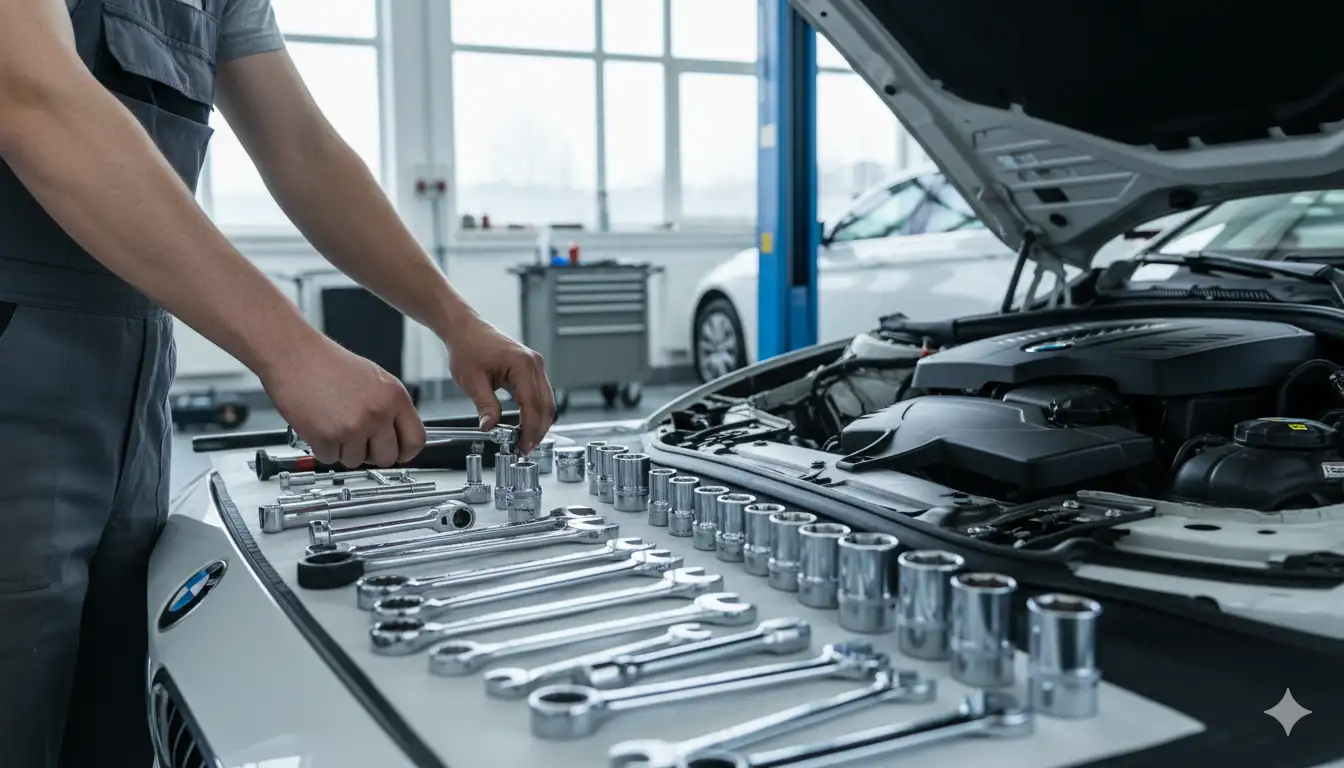
Key Takeaways
- E-Torx sockets (E6-E24) are most critical for engine work, not traditional wrenches
- Triple Square (XZN) bits required for high-stress drivetrain and engine components
- Torque wrenches mandatory with 3/8″ drive for engine, 1/2″ for suspension
- 100% metric sizing following ISO standards, no SAE tools needed
- Angle torquing common on critical fasteners requiring degree measurement
- Oil filter wrenches specific to model, typically 86mm 16-flute most common
- Professional sets require $1,000-3,000 minimum investment for comprehensive coverage
Decision Path / Next Steps
- For DIY Beginners: Start with a quality E-Torx socket set (E6-E20), internal Torx bits (T10-T55), and basic metric sockets (8mm-19mm). Invest in a 3/8″ drive torque wrench (20-100 ft-lb) immediately—this prevents expensive damage. Add Triple Square bits as needed for specific repairs. Budget $300-500 for essential tools covering 80% of basic maintenance.
- For Serious DIY Mechanics: Build comprehensive E-Torx (E4-E24) and Torx (T6-T60) collections in multiple drive sizes. Purchase both 3/8″ and 1/2″ torque wrenches with angle gauges. Add model-specific tools like oil filter wrenches and timing tools. Consider used BMW purchases to justify $1,000-2,000 tool investment.
- For Specific Model Owners: Research your engine code (N52, N54, B58, etc.) to identify unique tool requirements. Join model-specific forums for tool recommendations from experienced owners. Purchase timing tools only if planning timing chain/VANOS work. Rent or borrow specialized tools for one-time repairs.
- For Professional Aspirants: Invest in complete German-made tool sets prioritizing durability over price. Add BMW factory special tools as repair frequency justifies cost. Consider diagnostic equipment (ISTA-D) for comprehensive capability. Budget $5,000+ for professional-grade tool collection supporting all BMW repairs.
FAQs
Are all the bolts on a BMW engine metric?
Yes, BMW uses metric fasteners exclusively, following German ISO standards. However, many are Torx/E-Torx rather than traditional hex bolts.
Why does BMW use E-Torx bolts on their engines?
E-Torx provides superior torque transfer, reduces cam-out risk, and allows precise torque-plus-angle tightening required for critical engine components.
What E-Torx socket sizes are most common for BMW engine work?
E10, E12, E14, and E16 are most frequently used, though a complete E6-E24 set is recommended for comprehensive coverage.
Do I need a Triple Square (XZN) set for my BMW engine?
Yes for certain drivetrain and highly-stressed components, particularly on transmission-to-engine bolts and some cylinder head applications.
What specific size spark plug socket do I need for a BMW N55 engine?
BMW N55 engines require a 14mm 12-point thin-wall spark plug socket with adequate reach for the deep spark plug wells.
What are the must-have wrench sizes for working on a BMW?
10mm, 13mm, 16mm, and 18mm are most common, though sockets are used far more frequently than open-end wrenches.
Can I use standard Torx bits on an external (E-Torx) BMW bolt?
No, E-Torx (external) requires special sockets with internal star pattern, opposite of standard Torx bits.
What is the torque-to-yield or angle torquing procedure on a BMW?
Initial torque specification followed by additional rotation degrees (e.g., 90°) for stretch bolts that cannot be reused.
Are there any special tools required for a BMW oil change?
Yes, most modern BMWs require a specific fluted cap wrench (typically 86mm 16-flute) for the plastic oil filter housing.
References
- E90Post Forums. (2018). Ultimate tool list for working on BMWs. https://www.e90post.com/forums/showthread.php?t=1221888
- BimmerWorld. (2024). BMW Handtools – Screwdrivers, Wrenches & Sockets. https://www.bimmerworld.com/Tools/BMW-Handtools-Screwdrivers-Wrenches-Sockets-Pliers/
- Reddit BmwTech. (2024). Metric wrench sizes. https://www.reddit.com/r/BmwTech/comments/199djc7/metric_wrench_sizes/
- F30 BimmerPost. (2018). Drive size for sockets. https://f30.bimmerpost.com/forums/showthread.php?t=1546179
- E90Post Forums. (2017). List of essential External Torx socket sizes. https://www.e90post.com/forums/showthread.php?t=689886
- JB Tools. (2025). Triple Square (XZN) Bit Sockets for Euro Cars. https://www.jbtools.com/triple-square-bit-sockets/
- YouTube. (2024). N55 Valve Cover Torque Sequence. https://www.youtube.com/watch?v=fx2gxkKsp2g
- E90Post Forums. (2017). Torque Specs Thread. https://www.e90post.com/forums/showthread.php?t=1362166
- BimmerForums. (2010). Best torque wrench for my needs. https://www.bimmerforums.com/forum/showthread.php?1366685-Best-torque-wrench-for-my-needs
- Reddit BMW. (2022). Torque spec for coolant flange N55. https://www.reddit.com/r/BMW/comments/u37ewx/can_anyone_please_help_me_find_the_torque_spec/
- BimmerForums. (2013). N54 oil pan bolt torque. https://www.bimmerforums.com/forum/showthread.php?2014974-n54-oil-pan-bolt-torque

I am a senior automotive analyst at Autvex. Expert vehicle evaluations, in-depth reviews, and objective analysis helping readers make informed automotive decisions with years of industry experience.

